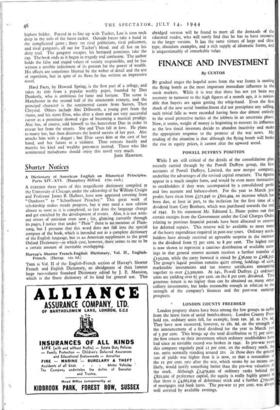FINANCE AND INVESTMENT
By CUSTOS
BY gradual stages the hopeful news from the war fronts is ousting the flying bomb as the, most important immediate influence in the stock markets. While it is true that there has not yet been any recovery in turnover to the high figures of a month ago, it is notice- able that buyers are again getting the whip-hand. Even the first shock of the new aerial bombardment did not precipitate any selling, such trivial falls as were recorded having been due almost entirely to the usual protective tactics of the jobbers in an uncertain phase. Now, it seems, weight of money is beginning to reassert its influence as the less timid investors decide to abandon inactivity and make the appropriate response to the promise of the war news. My reading of the situation is that although the flying bomb will brake the rise in equity prices, it cannot alter the upward trend.
POWELL DUFFRYN POSITION
While I am still critical of the details of the consolidation plan recently carried through by the Powell Duffryn group, the first accounts of Powell Duffryn, Limited, the new merger company, underline the advantages of the revised capital structure. The figures appear in a much simpler form, and would be even more instructive to stockholders if they were accompanied by a consolidated profit and loss account and balance-sheet. For the year to March 31st profits have risen from £571,946 to L602,494, an increase which has been due, at least in' part, to the inclusion for the first time of a dividend from Cory Brothers, which was purchased towards the end of 1942. In his statement Mr. Edmund L. Hann points out that certain receipts from the Government under the Coal Charges Order relating to previous financial periods have been allocated to reserve for deferred repairs. This reserve will be available to meet some of the heavy expenditure required in post-war years. Ordinary stock- holders have already received an agreeable surprise in the increase in the dividend from 74 per cent. to 8 per cent. The higher rate is now shown to represent a cautious distribution of available earn- ings in that general reserve account receives a further transfer of D50,000, while the carry forward is raised by £36,000 to £168,351 The group's liquid position remains quite strong, holdings of cash, marketable investments and tax reserve certificates amounting together to over £3,300,000. At 24s., Powell Duffryn ordinary units are yielding over 64 per cent. on the 8 per cent. dividend. This generous ieturn is no higher than can be obtained on, many other colliery investments, but lots reasonable enough in relaton to the strength of the company's finances and the post-war earnings prospects.
LONDON COUNTY FREEHOLD .
London property shares have been among the few groups to suffer
from the latest form of aerial bombardment. London County Free- hold ros. ordinary units fell, for example, from 195. 3d. to 17s. a They have now recovered, however, to as. 6d. on the strength of
the announcement of a final dividend for the year to March 3isl of 5 per cent. This brings up the total distribution to 74 per cent.,
the first return on their investment which ordinary stockholders have had since an enviable record was broken in 1941. In pre-war years this company regularly paid it per cent, on the ordinary stock, the tos. units normally standing around 21s. In those days the general sun of yields was higher than it is now, so that a restoration of the it per cent, rate after the war, which seems by no means un- likely, would justify something better than the pre-war valuation oi the stock. Although L2,479,000 of ordinary ranks behind tit'''. L821,000 of preference capital, the equity is really highly geared in that there is £4,665,639 of debenture stock and a further £720,003 of mortgages and bank loans. The pre-war it per cent, was alwaYs well covered by available earnings.


























 Previous page
Previous page